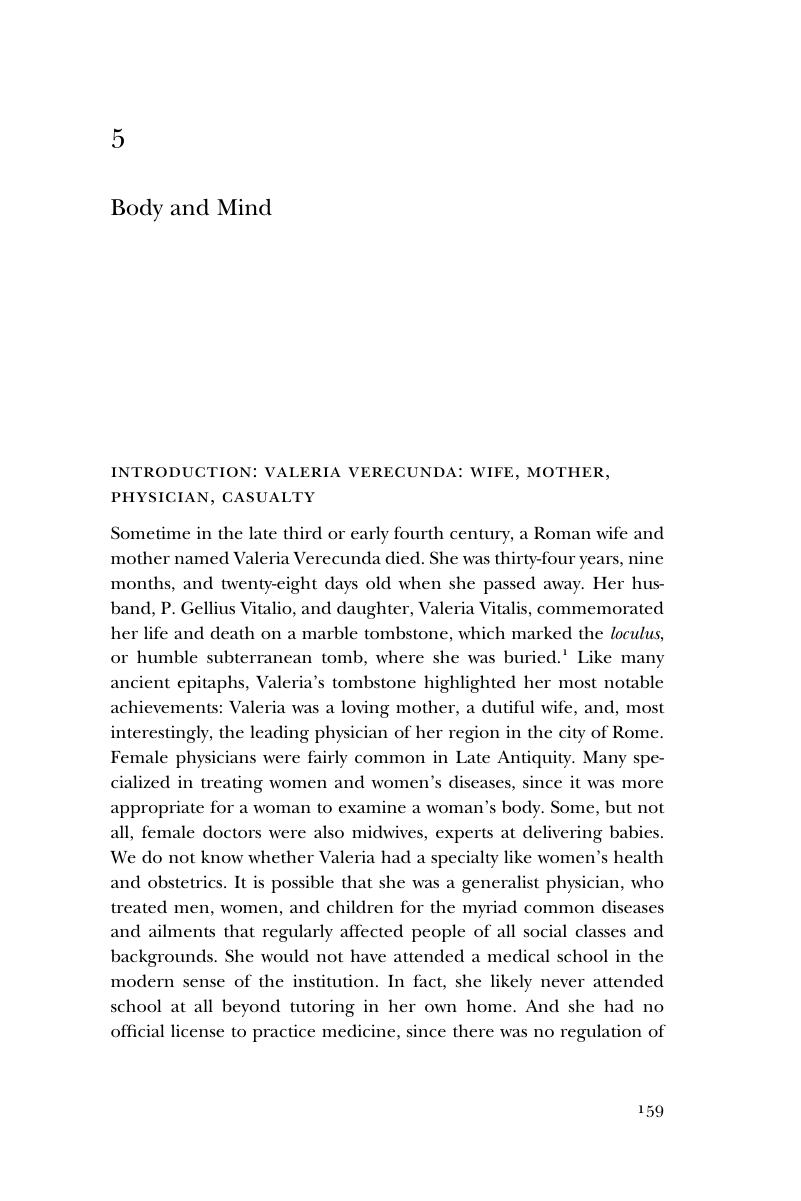Published online by Cambridge University Press: 18 June 2018

Readers interested in the general history of ancient medicine, including that of Late Antiquity, should consult H. King, Greek and Roman Medicine (London, 2001), and V. Nutton, Ancient Medicine (London, 2004) and “From Galen to Alexander: Aspects of Medicine and Medical Practice in Late Antiquity,” Dumbarton Oaks Papers 38 (1984): 1–14. On the history of health care in Late Antiquity, the earliest hospitals in the Roman Empire, and their link to early Christianity, see A. Crislip, From Monastery to Hospital: Christian Monasticism and the Transformation of Healthcare in Late Antiquity (Ann Arbor, MI, 2005). Those interested specifically in disease should read Ralph Jackson, Doctors and Diseases in the Roman Empire (London, 1988), especially for its images of surgical instruments, R. Sallares, Malaria and Rome: A History of Malaria in Ancient Italy (Oxford, 2002), and B. Shaw, “Seasons of Death: Aspects of Mortality in Ancient Rome,” Journal of Roman Studies 86 (1996): 100–138. Contraception and abortion are discussed in E. Eyeben, “Family Planning in Greco-Roman Antiquity,” Ancient Society 11/12 (1980–1981): 5–82. For the Justinianic plague, see the essays in Plague and the End of Antiquity: The Pandemic of 541–750, ed. L. Little (Cambridge, 2006).
For ancient education, see E. Watts, City and School in Late Antique Athens and Alexandria (Berkeley, CA, 2006), R. Kaster, Guardians of Language: The Grammarian and Society in Late Antiquity (Berkeley, CA, 1988), and H. I. Marrou, A History of Education in Antiquity (New York, 1956). For a general introduction to ancient sexuality, see M. Skinner, Sexuality in Greek and Roman Culture (London, 2005). And for the impact of Christianity on sex and the body, start with P. Brown, The Body and Society: Men, Women, and Sexual Renunciation in Early Christianity (New York, 1988). On clothing, see A. T. Croom, Roman Clothing and Fashion (Stroud, UK, 2002), M. Harlow, “Female Dress, Third-Sixth Century: The Messages in the Media,” Antiquité Tardive 12 (2004): 203–215, and K. Olson, Dress and the Roman Woman: Self-Presentation and Society (Milton Park, UK, 2008). On apotropaic clothing, see J. Ball, “Charms: Protection and Auspicious Motifs,” in Designing Identity: The Power of Textiles in Late Antiquity (Princeton, 2016), pp. 54–65. J. Arnold, “Theoderic’s Invincible Mustache,” Journal of Late Antiquity 6.1 (2013): 152–183 tackles the always pertinent matter of male facial hair.
To save this book to your Kindle, first ensure no-reply@cambridge.org is added to your Approved Personal Document E-mail List under your Personal Document Settings on the Manage Your Content and Devices page of your Amazon account. Then enter the ‘name’ part of your Kindle email address below. Find out more about saving to your Kindle.
Note you can select to save to either the @free.kindle.com or @kindle.com variations. ‘@free.kindle.com’ emails are free but can only be saved to your device when it is connected to wi-fi. ‘@kindle.com’ emails can be delivered even when you are not connected to wi-fi, but note that service fees apply.
Find out more about the Kindle Personal Document Service.
To save content items to your account, please confirm that you agree to abide by our usage policies. If this is the first time you use this feature, you will be asked to authorise Cambridge Core to connect with your account. Find out more about saving content to Dropbox.
To save content items to your account, please confirm that you agree to abide by our usage policies. If this is the first time you use this feature, you will be asked to authorise Cambridge Core to connect with your account. Find out more about saving content to Google Drive.